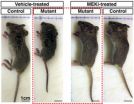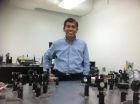(Press-News.org) Fampridine (trade name Fampyra®) has been approved in Germany since July 2011 for adult patients suffering from a higher grade walking disability (grades 4 to 7 on the EDSS disability status scale), as a result of multiple sclerosis (MS). The German Institute for Quality and Efficiency in Health Care (IQWiG) has assessed the added benefit of the drug pursuant to the Act on the Reform of the Market for Medicinal Products (AMNOG). According to the findings, there is no proof of added benefit, as the manufacturer's dossier contains no evaluable study data for the comparison between fampridine and the appropriate comparator therapy.
G-BA specifies physiotherapy as the appropriate comparator therapy
MS is a chronic incurable inflammatory disease, in which the patient's own immune system damages nerve tracts in the brain and spinal cord. In some patients, some muscles are in permanent spasm or are paralysed. If the disease is more advanced, patients may develop a walking disability.
The Federal Joint Committee (G-BA) has specified physiotherapy as the appropriate comparator therapy for the benefit assessment. This treatment must fulfil the requirements of the German Guideline on Remedies (Heilmittelrichtlinie). In addition, the patients must receive optimized standard therapy for MS.
Requirements for an indirect comparison not fulfilled
There are no studies that directly compare fampridine with physiotherapy. Instead, the pharmaceutical company presented data on an indirect comparison. These data originate from studies in which fampridine was compared with a placebo or in which physiotherapy was compared with "no treatment".
The legal ordinance on AMNOG explicitly specifies that it is possible to prove added benefit using indirect comparisons too. However, specific methodological conditions apply, which were not fulfilled by the manufacturer in the fampridine dossier.
Marked differences in the grade of disability
In addition, the studies on physiotherapy which the pharmaceutical company has evaluated cannot be used, as they also included patients with a markedly lower grade of disability (EDSS from 1.5) than in the studies on fampridine. Thus, the populations were not similar enough to allow a comparison between the results.
Finally, the manufacturer does not discuss in the dossier whether the physiotherapy tested in these studies was in accordance with the criteria of the Guideline on Remedies and, if this is not the case, why these studies would nevertheless allow conclusions about the situation in Germany. Moreover, the manufacturer does not mention whether the patients actually received optimized MS standard therapy. However, these two points are conditions specified by the G-BA for the appropriate comparator therapy.
Hence the manufacturer did not present evaluable studies on the appropriate comparator therapy for the assessment of the added benefit of fampridine, thereby also failing to present an evaluable indirect comparison. Thus there is no proof of added benefit of fampridine.
G-BA decides on the extent of added benefit.
The dossier assessment is part of the overall procedure for early benefit assessment conducted by the G-BA. After publication of the manufacturer's dossier and its assessment by IQWiG, the G-BA initiates a formal commenting procedure which provides further information and can result in a change to the benefit assessment. The G-BA then decides on the extent of the added benefit, thus completing the early benefit assessment.
###
An overview of the results of the benefit assessment by IQWiG is given by the following extract. You can also find easily understandable and brief German-language information about fampridine on the website gesundheitsinformation.de, published by IQWiG.
The G-BA website contains both general English-language information about the procedure of benefit assessment pursuant to §35a Social Code Book V and specific German-language information on the assessment of fampridine.
Added benefit of fampridine is not proven
Drug manufacturer did not present evaluable study data on the appropriate comparator therapy
2012-08-29
ELSE PRESS RELEASES FROM THIS DATE:
Could a cancer drug potentially prevent learning disabilities in some kids?
2012-08-29
ANN ARBOR, Mich. — A drug originally developed to stop cancerous tumors may hold the potential to prevent abnormal brain cell growth and learning disabilities in some children, if they can be diagnosed early enough, a new animal study suggests.
The surprising finding sets the stage for more research on how anti-tumor medication might be used to protect the developing brains of young children with the genetic disease neurofibromatosis 1 -- and other diseases affecting the same cellular signaling pathway.
The findings, made in mice, are reported in the journal Cell ...
Belimumab for lupus erythematosus: Added benefit not proven
2012-08-29
Belimumab (trade name Benlysta ®) has been approved since July 2011 as an add-on therapy for adult patients with the autoimmune disease systemic lupus erythematosus (SLE). This monoclonal antibody is only considered as treatment when the disease is still active in spite of standard therapy. The German Institute for Quality and Efficiency in Health Care (IQWiG) has now examined the added benefit of this drug pursuant to the Act on the Reform of the Market for Medicinal Products (AMNOG).
According to the findings, there is no proof that belimumab provides added benefit ...
Mount Sinai researchers solve mystery surrounding the death of two sisters nearly 50 years ago
2012-08-29
Researchers at Mount Sinai School of Medicine have identified the genetic cause of a rare and fatal bone disease by studying frozen skin cells that were taken from a child with the condition almost fifty years ago. Their study, which details how the MT1-MMP gene leads to the disease known as Winchester syndrome, appears in the August 23, 2012 online edition of The American Journal of Human Genetics.
In 1969, Patricia Winchester, MD, a pediatric radiologist in New York City, was asked to diagnose two young sisters who were losing bone in their hands and feet, developing ...
Biomass characterization technology research highlighted in Industrial Biotechnology journal
2012-08-29
New Rochelle, NY, August 29, 2012--Biomass recalcitrance--the problem of how to break down complex plant-based cellulosic feedstock into sugars that can be fermented to produce sustainable biofuels and other renewable biobased products—can be overcome through improved methods of biomass characterization. IB IN-DEPTH, a collection of articles from leading research laboratories describing advanced tools and techniques for analyzing the chemistry, structure, and interaction of biomass components, is published in Industrial Biotechnology, a peer-reviewed journal from Mary Ann ...
Chimpanzees create social traditions
2012-08-29
A research collaboration between the Gonzaga University and the Max Planck Institute shows that the way in which chimpanzees groom each other depends on the community to which they belong. Specifically, it is the unique handclasp grooming behaviour that reveals this local difference.
The specific behaviour that the researchers focused on was the 'grooming handclasp', a behaviour where two chimpanzees clasp onto each other's arms, raise those arms up in the air, and groom each other with their free arm. This behaviour has only been observed in some chimpanzee populations. ...
Breakthrough in nanotechnology
2012-08-29
A University of Central Florida assistant professor has developed a new material using nanotechnology, which could help keep pilots and sensitive equipment safe from destructive lasers.
UCF Assistant Professor Jayan Thomas, in collaboration with Carnegie Mellon University Associate Professor Rongchao Jin chronicle their work in the July issue of the journal Nano Letters. (http://dx.doi.org/10.1021/nl301988v)
Thomas is working with gold nanoparticles and studying their properties when they are shrunk into a small size regime called nanoclusters. Nanoparticles are already ...
Soaking up the Sun
2012-08-29
Solar panels, like those commonly perched atop house roofs or in sun-drenched fields, quietly harvesting the sun's radiant energy, are one of the standard-bearers of the green energy movement. But could they be better – more efficient, durable and affordable? That's what engineers from Drexel University and The University of Pennsylvania are trying to find out, with the aid of a little nanotechnology and a lot of mathematical modeling.
A three-year grant from the National Science Foundation has set the team on a track to explore ways to make new photoelectric cells more ...
TacSat-4 participates in Navy fleet experiment Trident Warrior
2012-08-29
WASHINGTON –- U.S. Naval Research Laboratory's Tactical Satellite-4 successfully completes three weeks of intense testing, June 28, as part of the Navy's annual Trident Warrior Experiment 2012 (TW12). TacSat-4 is a Navy-led Joint mission that provides Ultra High Frequency (UHF) satellite communications (SATCOM).
Sponsored by Navy Warfare Development Command, Trident Warrior is an annual fleet experiment focused on gaining valuable insights to improve future capability investments. This year's agenda included at-sea experimentation of critical maritime initiatives, and ...
Many trendy 'microgreens' are more nutritious than their mature counterparts
2012-08-29
The first scientific analysis of nutrient levels in edible microgreens has found that many of those trendy seedlings of green vegetables and herbs have more vitamins and healthful nutrients than their fully grown counterparts. A report on the research appears in ACS' Journal of Agricultural and Food Chemistry.
Qin Wang, Gene E. Lester and colleagues point out that microgreens have gained popularity as a new culinary trend over the past few years, especially in upscale markets and restaurants. Those seedlings of spinach, lettuce, red cabbage and other veggies are usually ...
Warning on deterioration of famous Swedish warship, Vasa
2012-08-29
The famous warship, Vasa, displayed in a museum that gets 1.2 million visitors every year and ranks as one of Sweden's most popular tourist attractions, is deteriorating despite ongoing preservation efforts, scientists are reporting. Their study, citing a "significant" loss of strength in the ship's wood, appears in ACS' journal Biomacromolecules.
Ingela Bjurhager, Lars A. Berglund and colleagues explain that the Vasa sunk in the Stockholm harbor in 1628 on its maiden voyage after sailing less than a nautical mile. The ship was rediscovered in 1958, raised in 1961, treated ...
LAST 30 PRESS RELEASES:
First Editorial of 2026: Resisting AI slop
Joint ground- and space-based observations reveal Saturn-mass rogue planet
Inheritable genetic variant offers protection against blood cancer risk and progression
Pigs settled Pacific islands alongside early human voyagers
A Coral reef’s daily pulse reshapes microbes in surrounding waters
EAST Tokamak experiments exceed plasma density limit, offering new approach to fusion ignition
Groundbreaking discovery reveals Africa’s oldest cremation pyre and complex ritual practices
First breathing ‘lung-on-chip’ developed using genetically identical cells
How people moved pigs across the Pacific
Interaction of climate change and human activity and its impact on plant diversity in Qinghai-Tibet plateau
From addressing uncertainty to national strategy: an interpretation of Professor Lim Siong Guan’s views
Clinical trials on AI language model use in digestive healthcare
Scientists improve robotic visual–inertial trajectory localization accuracy using cross-modal interaction and selection techniques
Correlation between cancer cachexia and immune-related adverse events in HCC
Human adipose tissue: a new source for functional organoids
Metro lines double as freight highways during off-peak hours, Beijing study shows
Biomedical functions and applications of nanomaterials in tumor diagnosis and treatment: perspectives from ophthalmic oncology
3D imaging unveils how passivation improves perovskite solar cell performance
Enriching framework Al sites in 8-membered rings of Cu-SSZ-39 zeolite to enhance low-temperature ammonia selective catalytic reduction performance
AI-powered RNA drug development: a new frontier in therapeutics
Decoupling the HOR enhancement on PtRu: Dynamically matching interfacial water to reaction coordinates
Sulfur isn’t poisonous when it synergistically acts with phosphine in olefins hydroformylation
URI researchers uncover molecular mechanisms behind speciation in corals
Chitin based carbon aerogel offers a cleaner way to store thermal energy
Tracing hidden sources of nitrate pollution in rapidly changing rural urban landscapes
Viruses on plastic pollution may quietly accelerate the spread of antibiotic resistance
Three UH Rainbow Babies & Children’s faculty elected to prestigious American Pediatric Society
Tunnel resilience models unveiled to aid post-earthquake recovery
Satellite communication systems: the future of 5G/6G connectivity
Space computing power networks: a new frontier for satellite technologies
[Press-News.org] Added benefit of fampridine is not provenDrug manufacturer did not present evaluable study data on the appropriate comparator therapy



